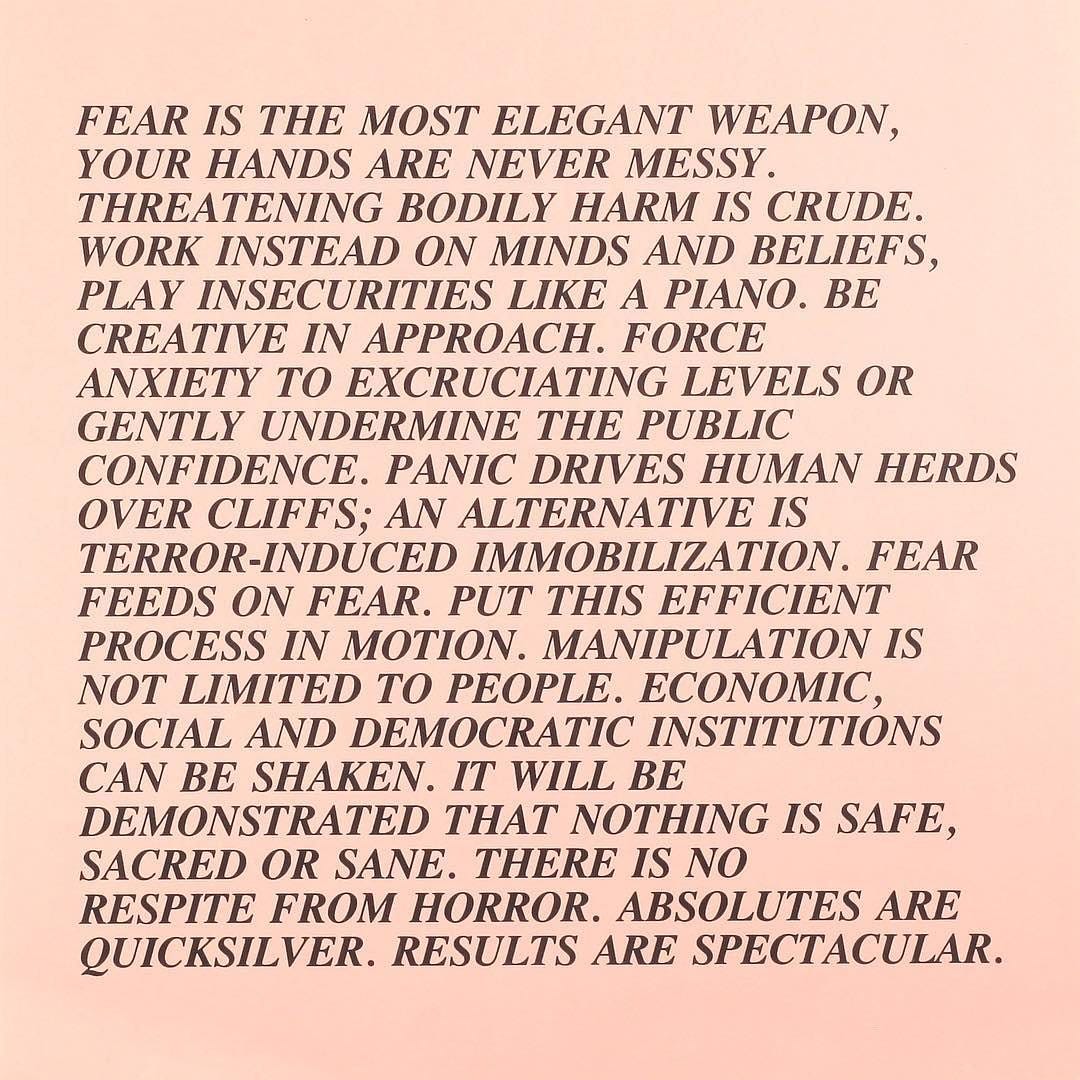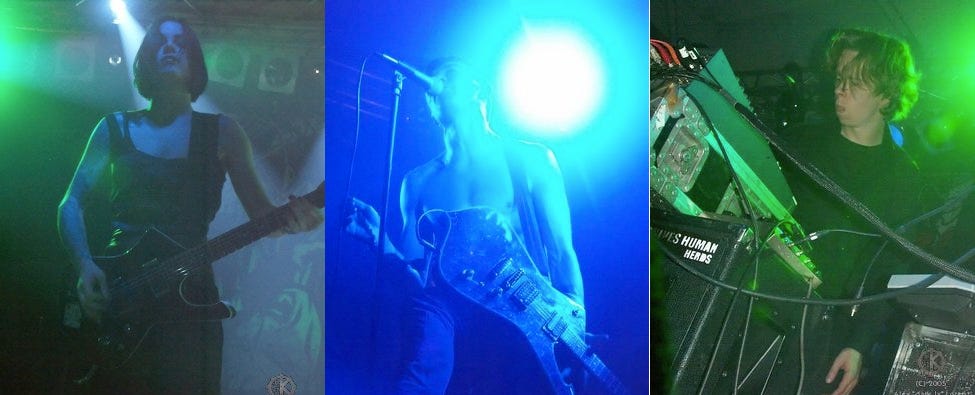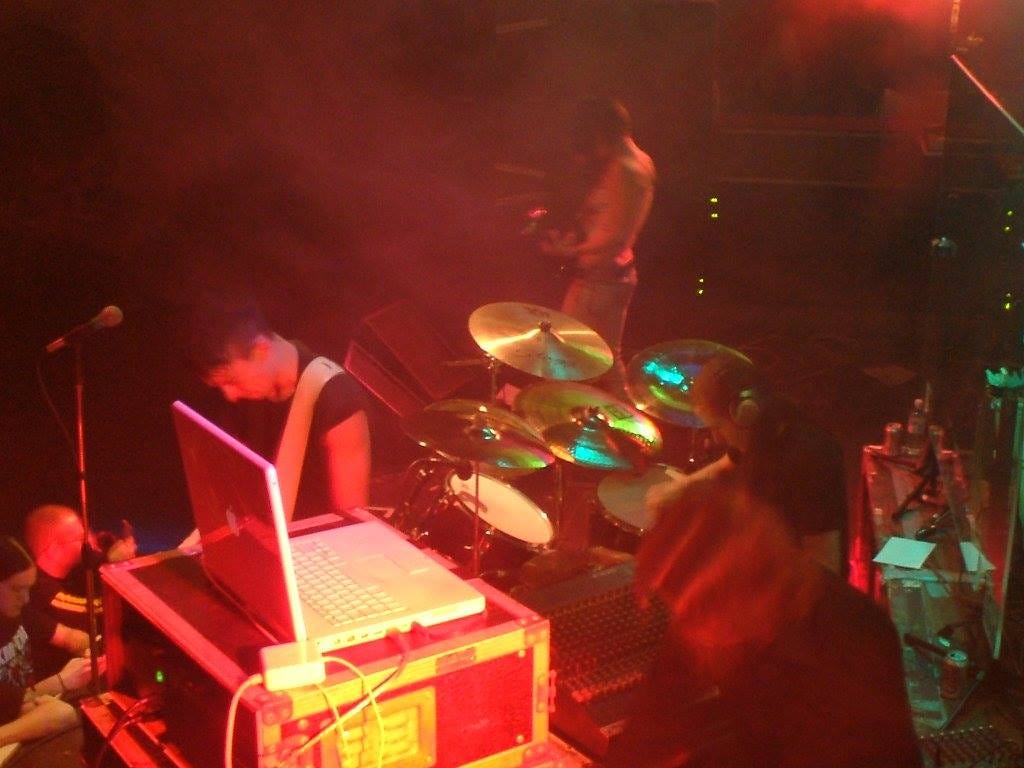(unless you're one of those lucky so-and-sos who saw them live in the early 00s, or you read this (very) long piece when I originally posted it on Medium)

Jenny Holzer - "Panic drives human herds over cliffs;
an
alternative is terror-induced immobilization."
Having made some spectacularly poor lifestyle decisions in my teens, 20s and 30s, I don't necessarily agree with the idea that one regrets the things they didn't do in life more than those that they did do, but when it comes to music I'll make an exception.
I regret not discovering this band sooner. Not just because of the astonishing live experience they reportedly offered - although I certainly do wish I could trade every insultingly phoned-in KMFDM and Ministry "performance" I've seen for half an hour of Panic DHH's venemous mechanised assault in an East Midlands pub - but because it would have saved me a lot of money and effort spent trying to find where the rest of the Good Industrial Metal was hiding.
Spoiler alert: there is very little good industrial metal hiding out there. Take your favourite Paul Barker era Ministry album, the first three Cubanate albums, and 2004's Panic Drives Human Herds, and go live on a desert island where you never have to worry about the subgenre again. I am not exaggerating when I say this album has become the unbeatable benchmark for guitar-based industrial for me.
Before I open the floodgates and subject the reader to a litany of things I love about this album - as countless friends of a goth/alternative/industrial persuasion have endured at house parties over the years - let me get the sole (heavily qualified) criticism I have out of the way. Many of the songs on this album share a similar structure and the same sonic palette, something which would have become more apparent if I had written this piece as a track-by-track review. However, the album's conciseness - eight songs, two instrumentals, all clocking in at just over three quarters of an hour-means it's harder to pinpoint the filler than the standout tunes.
"The time I remember seeing them was on an odd bill at The Garage featuring, I think, Nasum and either Extreme Noise Terror or Mclusky. [...] It's a shame they disappeared so quickly as they were fantastic." - my buddy Mark

Source: popmonitor.de
Of course, I wouldn't be rhapsodising about this record if it was simply a competent, accessible genre excercise. The attention paid to dynamics and space, noise and silence elevates this far above the legions of off-brand Reznors the late 90s threw up. The fact that Panic DHH formed in London still astonishes me - 99% of the bands I like who do this sort of thing are North American (by which I mean they're inevitably from Chicago). Their apparent outsider status is also fascinating: they don't seem to have sprung from the loins of the Official 21st Century UK Goth/Industrial scene like contemporaries Inertia or M.E.S.H. Panic Drives Human Herds was released on Alec Empire's Digital Hardcore label (Panic frontman Robbie Furze was Empire's touring guitarist at one point) but that DHR connection is the closest Panic DHH come to fitting into any industrial scene "traditions" or tendencies.
"I saw them supporting Mortiis in Sheffield (2005), when they blew him off the stage. It was in the small room of Corp, and they were unbelievably loud. Everything seemed to be performed with pure spite. Then there was a chaotic time supporting KMFDM in Nottingham (the Hau Ruck tour, later in 2005). For reasons never fully explained, doors didn't open until after 21:00, and Panic DHH took the stage apparently seething at whatever had gone on, and it got louder and louder across the set until they got to "U Wish". There's a change in dynamics in the track that was always bracing on record, here the change hit with such force that it literally knocked us back a foot. I've never experienced anything like it." - my boy Adam (A Model Of Control)
In the early-mid 00s there appears to have been a backlash, of sorts, to the perceived effeminacy and poppiness of goth/industrial club superstars like VNV Nation and Covenant. This would unfortunately give rise to the Insane Clown Posse of industrial music a couple of years further down the line, but in the US it seemed to prompt a return to what many people in North America perceive as "old school" (ie 90s, guitar-based) industrial. The first Firewerk album is probably the finest product of this somewhat reactionary turn, if you're interested. But I don't believe Panic DHH made Panic Drives Human Herds for any reason other than they really wanted to. Or had a lot of stuff to get off their chest that couldn't be accurately conveyed through the medium of futurepop. Didn't stop them including what feels like a made-for-the-club banger, however, in the form of 'Reach'.
"I'd seen them...when they were supporting someone (Ultraviolence?) at Corporation. They were very loud, the room was vibrating. I enjoyed it, but given it was about 18 years ago I can't really remember much beyond LOUD for Panic DHH and BOUNCY for Ultraviolence." - my pal Daisy
The band and album name, too, suggest a more original propositon than the jaded rivethead in all of us might have come to expect. Sampling Full Metal Jacket? Nah mate, how about quoting American neo-conceptual artist Jenny Holzer instead? It feels Properly Industrial™ without invoking any of the genre's hackneyed naming conventions (they could have spelt it Panik like some third-rate aggrotech band, but mercifully they didn't).
I'd be hard-pressed to find anything cliched in the music itself, either. The 45 minutes of thrashing guitars, crushing drums, snarling vocals and white-noise-blizzard electronics that make up Panic Drives Human Herds seem almost too perfectly conceived, too true to a formula. But it's the electronics themselves, and the relegation of the guitars to the role of "producing one or two memorable hooks per track" rather than a crutch as so many riff-based industrial bands do, that keep this abrasive musical stew interesting and appetising. The loud/soft dynamics - best heard on the tuning-in-and-out-of-a-radio feel of 'Spare' and the contrast between 'Simplex (Starve)' and the two tracks either side of it - certainly don't hurt either.
"I booked them to play a gig locally after seeing them at SuperSonic...they really were wonderfully ferocious on stage and lovely off it (they all crashed at mine after) - kinda what I wish Ministry had been after Psalm 69..." - man like Lee Chaos
The intentional absence of guitar in some industrial rock - see Cocksure - can highlight the subgenre's debt to post-punk, with its (usually) highly prominent bass guitar. In DHH's case the intentional absence of bass guitar (save for on 'Sterile' and, if my ears don't deceive me, the instrumental Linctus) seems to enhance the overall electronic feel of the album, and steer it clear of too well-trodden territory.
Which isn't to say that the album lacks low-end punch - the whole affair judders and grinds with speaker-damaging heft. Robbie Furze (a former member of 90s alt rock curiosities Nojahoda) and Juliet Elliott's serrated riffs are so distorted, mangled and processed as to almost - but not quite - blend in seamlessly with the furious digital racket generated by Antti Usimaaki. The production allows just enough contrast between the electronic and the organic to remind you that this is - on perhaps a secondary level to being an industrial album - a metal album. I often catch myself absently humming the riffs on 'Latem' and 'Common Enemy'.

Source: Funeral Nation on Facebook
All this in such a lean, disciplined package: Panic DHH's
first, last and only studio album. Their swansong,
Electric Live Set, recorded at Electrowerkz in 2007 is certainly worth a
mention. You may recognise many of the loops and sounds - the
set is essentially the studio album's Atari-meets-NIN sound
stripped of all guitars, vocals and live drums, leaving a
blistering sonic assault and a tantalising glimpse of the band
Panic DHH might have evolved into.
Panic's understanding of noise and electronics on their sole
studio album demonstrated a genuine passion for and
understanding of electronic sounds as a sonic weapon in their
own right rather than a mere gimmick to add flavour to some
stodgy alternative metal. Their live album, which compares
favourably to many power noise works of the time, is a
vindication of this.
After that last hurrah, the different paths that the four members took after the end of Panic DHH demonstrate what a brutal, beautiful & bizarre one-off their career was. Producer, programmer and all-round electronics wizard Antti Uusimaki went on to dabble in all sorts of strange and interesting proggy electronic outfits, and mixed another favourite album of mine. Frontman Robbie formed a poppy shoegaze type outfit called The Big Pink, and somehow married someone even posher than himself (whose stepmum, incidentally, pioneered the ol' "trepanning the skull to reach nirvana" technique). Adam Lewis is somewhere out there still drumming for various bands. Guitarist Juliet appears to have hung up her axe and got really into cycling.
Whatever was troubling the members of Panic DHH when they decided to unleash this torrent of naked fury on the world, I'm glad they decided to share it with us. And although I'm still gutted about never seeing them live, I'm grateful they left the scene with this memory preserved in amber, never to be tainted by bumping into any of them at Slimelight trying in vain to be recognised by people who weren't even born in 2004.
Industrial metal is dead, long live industrial metal. Panic DHH killed it, in every sense of the word.